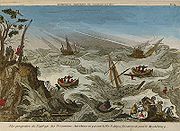
Zograscope
Encyclopedia

Depth perception
Depth perception is the visual ability to perceive the world in three dimensions and the distance of an object. Depth sensation is the ability to move accurately, or to respond consistently, based on the distances of objects in an environment....
from a flat picture. It consists of a large magnifying lens through which the picture is viewed. Some models have the lens mounted on a stand in front of an angled mirror
Mirror
A mirror is an object that reflects light or sound in a way that preserves much of its original quality prior to its contact with the mirror. Some mirrors also filter out some wavelengths, while preserving other wavelengths in the reflection...
. This allows someone to sit at a table and to look through the lens at the picture flat on the table. Pictures viewed in this way need to be left-right reversed; this is obvious in the case of writing (as shown along the top of the illustration). These pictures are called vues perspectives or perspective views.
According to Michael Quinion
Michael Quinion
Michael Quinion is a British etymologist and writer. He runs the web site World Wide Words, devoted to linguistics. He graduated from Cambridge University, where he studied physical sciences after which he joined BBC radio as a studio manager.-Writer:...
, the origin of the term is lost, but it is also known as a diagonal mirror, as an optical pillar machine, or as an optical diagonal machine.
Zograscopes were popular during the Georgian era
Georgian era
The Georgian era is a period of British history which takes its name from, and is normally defined as spanning the reigns of, the first four Hanoverian kings of Great Britain : George I, George II, George III and George IV...
as parlour entertainments. Most existing ones from that time are fine furniture, with turned stands, mouldings, brass fittings, and fine finishes.
A picture of a zograscope can be seen at Bright Bytes Studio.
How they work
One way a zograscope enhances depth perception is by minimizing other depth cues that specify the flatness and pictorial nature of the picture. The image is magnified, perhaps giving it a visual angleVisual angle
The visual angle is the angle a viewed object subtends at the eye, usually stated in degrees of arc.It also is called the object's angular size....
similar to the real scene the picture is depicting. The edges of the picture are blocked by the frame of the lens. The light coming from the lens to the eye
Human eye
The human eye is an organ which reacts to light for several purposes. As a conscious sense organ, the eye allows vision. Rod and cone cells in the retina allow conscious light perception and vision including color differentiation and the perception of depth...
is collimated, preventing accommodation
Accommodation (eye)
Accommodation is the process by which the vertebrate eye changes optical power to maintain a clear image on an object as its distance changes....
.
A second way a zograscope enhances depth perception is by creating stereopsis
Stereopsis
Stereopsis refers to impression of depth that is perceived when a scene is viewed with both eyes by someone with normal binocular vision. Binocular viewing of a scene creates two slightly different images of the scene in the two eyes due the the eyes' different positions on the head...
. Because each eye views the image from a different position, the visual directions of contours in the picture might differ for each eye, creating horizontal disparity. As well, coloured parts of the image will be refracted differently for each eye, creating a version of chromostereopsis
Chromostereopsis
Chromostereopsis is a visual illusion whereby the impression of depth is perceived in two-dimensional color images usually red-blue or red-green colors but can also be perceived with red-grey or blue-grey images. Such illusions have been reported for over a century and have generally been...
.
Build your own
A simple zograscope can be built from a frame (by cutting a rectangular opening in the bottom of a cardboard box) and placing in the frame a large, magnifying, fresnel lensFresnel lens
A Fresnel lens is a type of lens originally developed by French physicist Augustin-Jean Fresnel for lighthouses.The design allows the construction of lenses of large aperture and short focal length without the mass and volume of material that would be required by a lens of conventional design...
available from stationery stores. When this is placed over a computer monitor displaying a photograph of a natural scene, the depicted depth will be enhanced.

